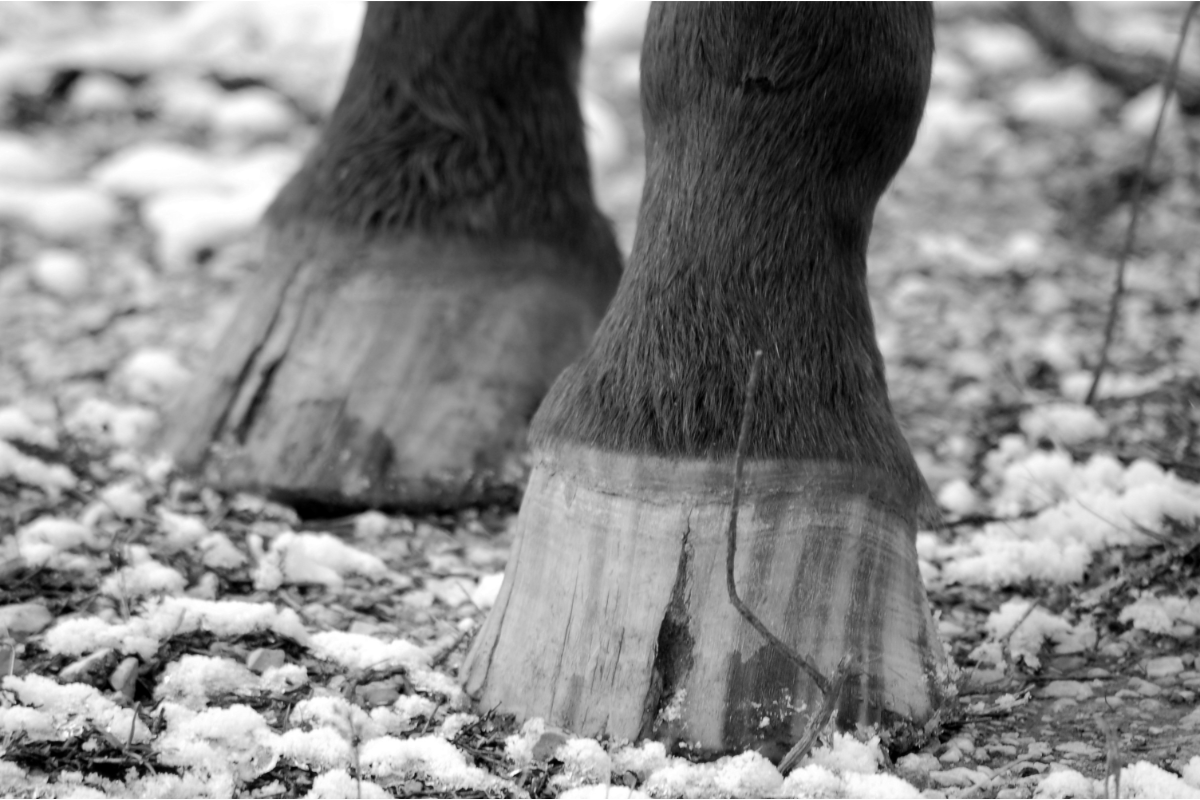Seime is a common condition in horses that can have serious consequences for their well-being and performance. Understanding the causes, symptoms, diagnostic methods and treatments available is essential for any horse owner.
What causes this condition?
A seime is a longitudinal crack in the hoof horn. It is often caused by dryness of the horn, making it brittle and of poor quality. This phenomenon is exacerbated if the horse is not shod, as the shoe protects the foot. Trauma and mechanical stress can also play a role in the appearance of seimes.
Seimes generally start at the bottom of the foot and work their way up towards the perioplic ridge, the area where the horn grows. Poor horn quality, due to lack of care and regular visits by the farrier, also contributes to their formation. The hoof grows by around 1 cm a month. This prolongs care, especially in serious cases where splitting the hoof from top to bottom fractures the perioplic pad and causes intense pain.
A fine line on the hoof wall can be used to visually detect the appearance of a seime. This crack may be ascending, starting at the crown, or descending, starting at the pincer. As the horse moves, the crack opens and closes. It pinches the flesh of the hoof, causing significant pain. Descending seimes are generally more serious, affecting horn regrowth and prolonging healing.
What are the symptoms of seime?
The main symptom of seime in horses is the appearance of a distinct crack in the hoof wall. This crack may be ascending, starting at the crown, or descending, starting at the toe. As the horse moves, the crack opens and closes, causing significant pain.
A symptom frequently associated with seime is lameness. This altered gait, where the horse tries to relieve pain by reducing pressure on the affected hoof, can be more pronounced on hard or uneven surfaces. Warmth in the hooves is also a common indicator, noticeable on palpation. This indicates a local inflammatory response.
Another tell-tale sign is an increased digital pulse. This condition is characterised by a more pronounced beating of the digital artery of the foot, detectable on palpation due to the inflammation. In addition, the horse may adopt an abnormal foreleg position to relieve pressure on the affected hoof, thus altering its usual posture.
A possible complication when seime is left untreated is anteater. This deterioration of the hoof area, caused by bacterial or fungal infection, can lead to further damage. Similarly, destruction of the lamellar tissue, essential for hoof stability, can occur. This exacerbates the pain and deterioration in hoof quality.
Finally, untreated seime can lead to complications such as rotation or tilting of the foot, altering the normal position of the foot and aggravating lameness. Systemic conditions, resulting from chronic pain, can also affect the horse’s general well-being.
How is the condition diagnosed?
Diagnosis of seime in horses begins with a careful examination of the hoof, including probing the hoof wall with probing forceps and percussion around the seime. A flexible tube can be inserted to assess the depth of the crack. An X-ray may also be useful to examine the extent of internal damage.
Seimes are divided into several types: rising seimes, which are often not serious and are easy to manage, and descending seimes, which can be more complicated, especially when they affect the heels or are secondary to old injuries. Rising seimes can sometimes be complicated by an anthill, requiring more intensive management.
Clinical examination helps to differentiate between rising and falling seimes and to assess the severity of the situation. Seimes secondary to old wounds, often involving the perioplic pad, are particularly difficult to manage, as they cannot be repaired, only managed.
What treatments are available?
Treating seime in horses requires a multi-dimensional approach. Regular, well-executed trimming is essential to maintain the natural balance of the hoof. For simple seimes, one or more well-placed rasp strokes can block the seime and prevent the cleft from progressing upwards.
What are the natural alternatives?
Some natural alternatives can be used to treat seime in horses. Herbal ointments and footbaths based on natural solutions can promote healing and protect the hoof from infection.Laurel oil, for example, is beneficial for horn hydration and growth.
Lanolin, extracted from sheep’s wool fat, is rich in fats and deeply nourishes the horn. It forms a protective film against external aggressions.Scots pine essential oil, renowned for its purifying properties, effectively purifies the hoof.
To keep hoof horn supple and prevent new cracks, apply a suitable moisturiser regularly. Pine tar-based poultices, with their antiseptic, waterproofing and healing properties, protect the hoof from dirt and bacteria.
What can be done to prevent hoof damage?
Preventing seime in horses is crucial to maintaining hoof health. Regular monitoring and regular visits to the farrier are essential to prevent this condition. Foot care includes regular trimming and daily cleaning to remove mud and debris.
Maintaining a healthy, balanced diet is also important in preventing seime. Effective weight control reduces hoof overload, minimising the risk of cracking. Monitoring grazing conditions is also essential, avoiding muddy or excessively wet areas that soften the hoof horn.
By implementing these preventive practices, you can reduce the risk of seime and ensure the health and well-being of your horse.





